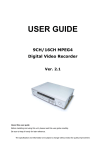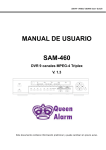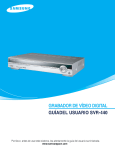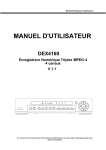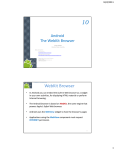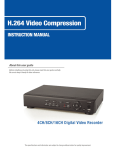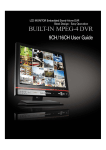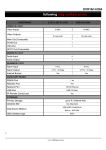Download USER GUIDE
Transcript
USER GUIDE 8 Channel MPEG-4 Triplex Digital Video Recorder Ver. 1.0 About this user guide Before installing and using this unit, please read this user guide carefully. Be sure to keep it handy for later reference. The specification and information are subject to change without notice for quality improvement. Safety Precautions Explanation of Graphical Symbols This symbol indicates the presence of important operating and maintenance (servicing) instruction in the literature accompanying the product. This symbol indicates the presence of un-protected ”dangerous voltage” within the product’s enclosure that may be of sufficient magnitude to constitute a risk of electric shock to persons. Cautions This product has multiple-rated voltages (110v and 220v). See installation instructions before connecting to the power supply. This product uses a Lithium battery. To avoid of risk of explosion, do not replace the battery on the main board by anything other than a Lithium battery. Dispose of used batteries according to the manufacturer’s instructions. This equipment and all communication wirings are intended for indoor use only. To reduce the risk of fire or electric shock, do not expose the unit to rain or moisture. 2 Warnings Installation and servicing should be performed only by qualified and experienced personnel. Power off the DVR when connecting cameras or sensor cables. The manufacturer is not responsible for any damage caused by improper use of the product or failure to follow instructions for the product. The manufacturer is not responsible for any problems caused by or resulting from the user physically opening the DVR for examination or attempting to fix the unit. The manufacturer may not be held liable for any issues with the unit if the warranty seal is removed. 3 Product Components The package contains the main unit and its components as specified below. When you purchase the unit, please check to ensure the components specified below are included DVR Set Client Software CD Remote Control Battery1.5V (AAA x 2EA) User Guide Rubber ring & Screws Power Cable IDE HDD Cable (2EA) Power Cord (110V or 220V) 4 Compatible HDD models Company Capacity RPM Buffer Interface 80 GB 7200 RPM 2M E-IDE 160 GB 7200 RPM 8M E-IDE 250 GB 7200 RPM 8M E-IDE 500 GB 7200 RPM 8M E-IDE 80 GB 7200 RPM 2M E-IDE 200 GB 7200 RPM 2M E-IDE 250 GB 7200 RPM 8M E-IDE 300 GB 7200 RPM 16 M E-IDE 80 GB 7200 RPM 2M E-IDE 160 GB 7200 RPM 2M E-IDE 160 GB 7200 RPM 2M E-IDE 200 GB 7200 RPM 8M E-IDE 250 GB 7200 RPM 8M E-IDE 320 GB 7200 RPM 8M E-IDE 40 GB 7200 RPM 2M E-IDE 80 GB 7200 RPM 2M E-IDE 120 GB 7200 RPM 2M E-IDE 160 GB 7200 RPM 2M E-IDE 300 GB 7200 RPM 8M E-IDE 400 GB 7200 RPM 8M E-IDE 500 GB 7200 RPM 8M E-IDE HITACHI MAXTOR SAMSUNG Western Digital SEAGATE 5 Specifications ITEM 8 Channel, 120 fps Channel, Input Level Input Video Composite 1.0Vp-p, 75 Ohm Signal Format NTSC/PAL(Auto detection) Video Loss Check Yes 1 CH Composite Output Main Monitor Output Output 15pin D-Sub RGB Output Output Level Signal Format Alarm 8 CH, Composite 1.0Vp-p +_0.2, 75 Ohm NTSC/PAL Analog SVGA(800x600 @75Hz, True Color) Sensor Input 4 (NC/NO Selectable) Alarm Output 1 ( By Alarm, Motion, Video Loss) Compression MPEG-4 Multi-operation TRIPLEX (Playback/Record/Network) MAX.120fps @ 352x240 NTSC MAX.60fps @ 704x240 MAX.30fps @ 704x480 Resolution Recording MAX. 100fps @ 352x288 PAL MAX. 50fps @ 704x288 MAX. 25fps @ 704x576 Display Recording quality grade LOW/STANDARD/HIGH/SUPER/ULTRA Recording Mode Continuous / Schedule / Motion/ Sensor/ Manual Motion Detection Motion detection setup by Grid Pre & Post Recording Yes Frame Rate(/sec) NTSC : 30fps/channel, 60 field PAL : 25fps/channel, 50 field Multi-Decoding 1, 4 split screen -> x2,4,8 8 split screen -> x2, 4 Playback Playback Fast Forward / Speed Reverse × 2, 4, 8 Search Mode Storage Internal HDD Interface Type Event, Archive, Log, Time Line EIDE/ATA133/S-ATA(option-External storage support) 6 Capacity of 1 1EA Max. 750GB HDD File system NaFS: Own developed & Designed for never broken by any power failure USB 2.0 flash Backup JPEG & AVI&DVR stick Network Moving picture & Still Image Menu Display Text UI Input Method Remote controller Dynamic IP support Yes Network Interface 10/100 base-T Ethernet (RJ-45) Network Functions Live, Search, Backup Client S/W Central Monitoring System Yes DLS (Day Light Saving) Yes Language Yes S/W Upgrade USB 2.0 memory stick Power Source DC 12V Unit Weight 1.6kg(Full package w/HDD : app.3.0kg) Dimension(WxHxD) 340x250x60mm User I/F Network Additional Functions General 7 TABLE OF CONTENTS 1. Features .................................................................................................................................10 2-1. Front Panel ................................................................................................................... 11 2-2. Rear Panel....................................................................................................................12 2-3. Remote controller .........................................................................................................13 3. Setting Up the DVR ...............................................................................................................14 3-1. Setup – Main Screen ....................................................................................................14 3-2. Setup – Live Mode........................................................................................................16 3-3. Setup – Recording Mode..............................................................................................16 3-3-1. Motion Zones .....................................................................................................18 3-3-2. Recording Schedule...........................................................................................18 3-4. Setup – Device Mode ...................................................................................................19 3-4-1. ALARM-OUT ......................................................................................................20 3-5. Setup – System Mode ..................................................................................................20 3-6. Setup – Security Mode .................................................................................................23 3-7. Setup – Network Mode .................................................................................................24 3-7-1. Ports...................................................................................................................25 3-7-2. Network types ....................................................................................................26 3-7-2-1. LAN .................................................................................................................26 3-7-2-1. DHCP..............................................................................................................27 3-7-2-1. ADSL (PPPOE) ...............................................................................................27 3-8. Setup - Storage Mode...................................................................................................28 3-9. Saving Setup ................................................................................................................29 4. Live & Search ........................................................................................................................29 4-1. Live Window .................................................................................................................29 4-2. SEARCH Window.........................................................................................................30 4-3. Play mode.....................................................................................................................31 4-4. LOG Search..................................................................................................................32 5. Archiving Video into USB Memory Device .........................................................................33 5-1. Capturing images or video............................................................................................33 5-1-1. Still Image backup onto USB flash memory or CD media..................................33 5-1-2. Video backup onto USB flash memory or CD media .........................................33 5-2. Transferring still images or video from the ARCHIVE list .............................................34 5-3. Playback of Backup Video............................................................................................35 5-3-1. Playback of backup video in AVI format .............................................................35 8 5-3-2. Playback of backup video in exclusive (NaFs) format........................................35 6. Upgrading Firmware .............................................................................................................36 7. Network – By an exclusive viewer.......................................................................................37 7-1. Overview.......................................................................................................................37 7-2. Minimum PC requirements ...........................................................................................38 7-3. Installing the program ...................................................................................................38 7-4. Live viewer....................................................................................................................39 7-5. Search and Playback Viewer........................................................................................41 7-5-1. Backup ...............................................................................................................42 7-6. PC System configuration ..............................................................................................42 7-6-1. General ..............................................................................................................43 7-6-2. Site .....................................................................................................................43 7-6-3. Event ..................................................................................................................44 7-6-4. Record................................................................................................................45 7-6-5. Disk ....................................................................................................................46 8. Network – By an web-browser viewer.................................................................................47 8-1. Download Web Brower Viewer and Connection...........................................................47 8-2. Main Features...............................................................................................................48 8-2-1. Live.....................................................................................................................48 -2-2. Search and Playback ...........................................................................................49 APPENDIX..................................................................................................................................50 1. How to register DDNS (Dynamic Domain Name Server) ................................................50 1-1. Setting of NETWORK Setup menu...............................................................................50 1-2. Checking Mac address on the rear panel of DVR and Registration No. ......................50 1-3. Registration at DDNS. ..................................................................................................51 2. Network access using Domain name ..............................................................................52 9 1. Features ● 8 channels real-time live display and 8 channels simultaneous playback. ● MPEG-4 - Unbeatable recording picture quality and compression ratio has been tuned for years. It best fits for minimizing recording space and networking speed. ● TRIPLEX - Simultaneous Recording, Playback, and Networking ● NaFS (File System developed) - Designed & developed for preventing loss and broke of recording data by any power failure. ● Multiplexing operation ● Reliability - Real Time Operating System and simplified hardware as well as watchdog timer ensure the reliability. ● Individual channel recording and playback with different frame rate. ● High-quality live and playback resolution. ● Multi-site management - Supported by CMS application. ● Network features - Remote Live, Playback, and Backup. ● Network via LAN, DHCP, ADSL (Dynamic and Static IP address). ● User-friendly setup menu with graphic user interface. ● Easy to schedule a complicated weekly recording plan. ● The OSD icons on screen provide various helpful and well-explained information. ● Motion detection – Grid 30x24 motion zone per camera is provided. ● USB ports for JPEG, MPEG data backup and software upgrade using USB flash memory stick. ● Still image capture and review as JPEG format. ● Easy operating with the buttons on the front and the remote controller. ● User verification by password certification. ● Video loss detection. ● Backup - Still-images or AVI data into USB flash memory stick, USB CDRW, and Network. ● Multi-Languages -User can easily select language from Setup menu. 10 2. Name, Function and Connection 2-1. Front Panel The following information will help you operate the front panel controls. Figure 2.1.1. Front panel Table2.1.1. Front LED and Port Name POWER HDD USB port Description LED Light is on when power is applied to the system. LED light is on when the system is accessing hard disk. There is a USB port located on the left side of the front panel. This USB port is used to archive footage into a USB storage device. 11 2-2. Rear Panel Figure 2.2.1. Rear Panel Table 2.2.1. Rear panel connections Connection VIDEO IN Purpose 8 connectors for video input. Connect camera output to Video-in (NTSC/PAL) VIDEO OUT VIDEO VGA 1 connectors for video output. Composite video output in NTSC or PAL format Connector for VGA monitor SENSOR IN Connector for sensor device connection. ALARM OUT 1 connector for alarm device connection. Provides simple On/Off switching by using relay. 0.5A/125V, 1A/30V LAN RJ45 connector for LAN connection. DC 12V Apply 12V DC using the DC adaptor supplied with the equipment. RS-232 For engineering use only. SWITCHES Select VGA monitor or CVBS (Composite Video Blanking Sync) monitor. Do not change the setting when the power is on. When the position of the switch is changed, the DVR should be rebooted to apply the new setting. 12 2-3. Remote controller F/REW Jump 60 seconds backward PLAY Play/Pause F/ADV Jump 60 seconds forward FF Fast Forward SETUP Setup menu screen SEQ Sequential channel conversion RECORD Manual recording SEARCH Search menu screen DIRECTION Direction or number 1 to 4 SELECT Enter ID DVR ID (ID Button + DVR ID number) ESC Esc NUMBER Channel 1 to 8 BACKUP Capture 13 3. Setting Up the DVR The following sections detail the initial setup of the DVR 3-1. Setup – Main Screen When you press the SETUP button, the DVR will ask for a password. The default password is 1111, which can be entered by pressing the up button 4 times and then pressing the SEL button. We recommend you protect the system by assigning a new password immediately. The procedure for assigning a password is found in section 3.6. After a password has been assigned, enter the password by using the direction keys (representing 1, 2, 3, & 4), and then press the SEL button for the password validation. Once the password is entered, you will see the screen as shown in Figure 3.1.1. Navigate through the menu items and press the SEL button to enter the sub-category menu. Figure 3.1.1. Setup menu screen 14 LIVE OSD SEQUENCE SEQ-DWEL TIME OSD CONTRAST CHANNEL RECORD DISPLAY, BRIGHTNESS, CONTRAST, HUE, SATURATION RESOLUTION CHANNEL Frame rate, Quality, Recording, Motion zone, Motion sensitivity, Sensor recording, Pre record, Post record, Schedule DEVICE ALARM OUT KEY TONE REMOTE CONTROL ID SENSOR SYSTEM TYPE DVR ID DESCRIPTION LANGUAGE LOAD FA CTORY DEFAULT LOAD DEFAULT DATE FORMAT SET DATE & TIME - DAY LIGHT SAVING SECURITY ADMIN PASSWORD USER PASSWORD NETWORK PASSWORD NETWORK PORT CLIENT ACCESS BANDWIDTH SAVING NETWORK TYPE – DHCP/LAN/ADSL(PPPOE) - DDNS STORAGE OVERWRITE FORMAT DISK INFO LOAD SETUP FROM A USB SAVE SETUP TO USB RECORD LIMIT RECORD LIMIT DAYS Table 3.1.1. Setup menu configuration 15 3-2. Setup – Live Mode Set the values for live display. Navigate through the menu items by pressing the UP or DOWN button. The value of the menu item may be changed by pressing the LEFT or RIGHT button. Figure 3.2.1. Live mode setup screen Table 3.2.1. Menu items in LIVE mode setup Item OSD SEQUENCE SEQ-DWELL TIME Description Enable/disable on-screen-display. Enable/disable SEQ button Set the dwell time for each, 4 or 9 channels display in sequential display mode. OSD CONTRAST Set the visibility level of the On Screen Display (OSD) CHANNEL Select the channel for applying the following settings. Press SELECT to change channel name. DISPLAY BRIGHTNESS CONTRAST HUE SATURATION Enable/disable display of the video channel in live display mode Change the brightness value for the specified channel Change the contrast value for the specified channel Change the hue value for the specified channel Change the saturation value for the specified channel 3-3. Setup – Recording Mode Set the values for recording video. Navigate through menu items by pressing the UP or DOWN button. User can change the value of the menu item by pressing the LEFT or RIGHT button. 16 Figure 3.3.1. Recording mode setup screen Table 3.3.1. Menu items in Recording mode setup Menu item RESOLUTION Description Set the resolution to either 704x480, 704x240, or 352x240 for NTSC. (PAL: 704*576/ 704*288/ 352*288) CHANNEL Select the channel to apply the following settings on. Changes you make will immediately take effect with the selected channel. FRAME RATE Set the frame rate for the specified channel. The sum of the frame rate values from each channel cannot exceed the maximum frame rates for a specific recording resolution. 120/100fps: 352*240(NTSC)/352*288(PAL) 60/50fps: 704*240(NTSC)/704*288(PAL) 30/25 fps: 704*480(NTSC)/704*576(PAL) QUALITY Select the recording quality for the specified channel. Options are: Network, Standard, High, Super or Ultra. RECORDING Set a recording mode for each channel. Select one of Continuous, By Motion, By Sensor, By Schedule or Disable. MOTION ZONE Select Full Zone or Partial Zone for motion sensing. MOTION SENSITIVITY Set the motion sensitivity for the specified channel. Control the motion sensitivity from 1 to 9. SENSOR Enable setting up to 4 sensors for the specified channel. RECORDING PRE RECORD Enable/disable pre-event recording. Pre-event recording time is 3 seconds and only intra-frames are recorded for pre-event recording. POST EVENT Set the post event recording time duration for the specified channel 17 RECORD SCHEDULE from 10 to 30 seconds. Set the recording schedule. 3-3-1. Motion Zones By selecting Partial Zone in the Motion Zone menu, user can set-up the motion sensing zones in the screen. Move around each rectangular zone using 4 direction key buttons and press SEL button to include the rectangular region as part of the motion sensing zone. The rectangular blocks included as part of the motion zone are indicated by changing the color of the blocks. Figure 3.3.2. Motion Zone selection screen 3-3-2. Recording Schedule To set up a recording schedule, select SCHEDULE in the RECORD menu. Use the arrow buttons to navigate through the items and set the recording. [ALL]: Selected recording mode using the SEL button is applied to the entire time zone and all channels. [SUN to SAT]: Selected recording mode using the SEL button is applied to the entire time zone for the specified channel. [Vertical Bar “ | “]: Selected recording mode using the SEL button is applied to the entire channel for the selected time zone. Each vertical bar “ | “ corresponds to one hour. [- Individual Block of Time]: Selected recording mode using the SEL button is applied to the selected 1-hour increment for the selected channel. [SEL]: The recording mode such as C (continuous), M (motion), S (sensor) and disable mode can be selected by using the SEL button. [COPY FROM to COPY TO]: Setup values of recording mode for the selected channel can be copied for another channel setup. 18 Figure 3.3.3. Schedule recording setup screen 3-4. Setup – Device Mode Set the values for device setting. Navigate through menu items by pressing the UP or DOWN button. User can change the value of the menu item by pressing the LEFT or RIGHT button. Figure 3.4.1. Device mode setup screen Table 3.4.1. Menu items in Device Setup screen Item ALARM-OUT KEY TONE REMOTE CONTROL ID Description Set the sensor, motion, and video loss for each alarm. Enable/disable key tone. Select a ID of remote controller. 1. Select ID. 2. Press the same number as ID set in DVR on a remote controller. 19 Before selecting ID, R:A is displayed as default on the live screen. Select sensor from 1 to 4. SENSOR Set the type of sensor for the specified channel. Options are: TYPE None, N/O (normal open), and N/C (normal closed). 3-4-1. ALARM-OUT Table 3.4.2. Menu item in ALARM-OUT Setup screen Item Description ALARM OUT Select alarm 1. SENSOR IN Enable setting up to 4 sensors of 4 sensors. MOTION ON Enable setting up to 4 cameras of 8 cameras. VIDEO LOSS ON Enable setting up to 4 cameras of 8 cameras. ALARM DURATION Set the dwell time of alarm from 3 to 255 seconds. Figure 3.4.2. Alarm-out setup screen 3-5. Setup – System Mode In this menu, system parameters can be input. Navigate through the menu items by pressing the UP or DOWN button. User can change the value of the menu items by pressing the LEFT or RIGHT button and UP or DOWN button. 20 Figure 3.5.1. System setup screen Table 3.5.1. Menu items in System Setup screen Item Description DVR ID The name of the system. Press the SEL button and move through the position for each alphanumeric character by pressing the LEFT or RIGHT button. UP or DOWN button is used to change the character for each location. 9 characters are available. DESCRIPTION LANGUAGE LOAD FACTORY System information. User can select a language. User can initialize all setting value as the factory default. DEFAULT LOAD DEFAULT Select OFF or ON. Select ON to load defaults. (Password, date format, DLS, Network setting, and HDD Overwrite will not be included.) DATE FORMAT SET DATE&TIME Select the preferred date and time display Set the present date, time and daylight saving for the DVR. DATE & TIME Set the present date and time for the DVR. Press SEL, then use the LEFT and RIGHT arrow controls to navigate through the position of each alphanumeric character in the date and time. Use the UP and DOWN arrow controls to change the selected character. Press ESC and select YES to confirm the new date and time. DAY LIGHT SAVING Set the DLS (Daylight Saving) for the area. The options are: OFF /USA / EU / Others/. 21 1. USA (DLS time is applied automatically when being on the DLS time zone and is displayed on the current time) 2. EU (Set the GMT area for DLS time apply on the current time) - GMT AREA +00:00 3. OTHERS 1ST SUN/00H) - BEGIN (MAR - END (SEP 1ST MON/00H) (Set the BEGIN and END time for the specific area except EU and USA) use the UP and DOWN arrow controls to change the value of month, week, day and hour. CAUTION: -Do not set the start time to 23:00 for DLS. -DLS can’t be applied, if the date of BEGIN and END is same. Figure 3.5.2. DVR ID setup screen Figure 3.5.3. DVR information display screen 22 Figure 3.5.4. Date & Time setup screen Figure 3.5.5. Daylight Saving setup screen 3-6. Setup – Security Mode In this menu, password and security parameters can be input. Navigate through the menu items by pressing the UP or DOWN button. User can change the value of the menu items by pressing the LEFT or RIGHT button. Figure 3.6.1. Security setup screen 23 Table 3.6.1. Menu Items in Security Setup Screen Item Description ADMIN Set a password for administrator. Once this menu is selected, the PASSWORD system will ask you current password and new password. Follow the procedure provided by the system. The password numbers can be input by using direction keys. The default password is 1111. ADMIN PASSWORD works on Setup, Record, Search and all operations. USER PASSWORD Set a password for user. Once this menu is selected, the system will ask you current password and new password. Follow the procedure provided by the system. The password numbers can be input by using direction keys. The default password is 1111. USER PASSWORD works for Search only. NETWORK Set a password for network client. Once this menu is selected, the PASSWORD system will ask you current password and new password. Follow the procedure provided by the system. The password numbers can be input by using direction keys. The default password is 1111. 3-7. Setup – Network Mode Network parameters can be input in this screen. These parameters are used for remote clients who are connected to the DVR over the network. Table 3.7.1. Menu items in Network Setup screen Item PORT CLIENT ACCESS BANDWIDTH SAVING NETWORK TYPE Description Port number (Default: 5445) Enable/Disable remote access through client software. Enable/Disable only key frame transmission. “ON” mode is favorable for use of low network bandwidth. Mostly, set “OFF” for normal use. Set the type of network connection. Options are: LAN, DHCP, ADSL Note. Other parts of the Network Setup screen change depending on what network type you select. DHCP Sets to use DHCP (If this is selected, DVR automatically get IP varying from time to time from network.) ADSL (PPPoE) ID: Registered ID is necessary for ADSL connection. Password: Registered pasword is necessary for ADSL connection. 24 LAN IP: Register IP address that is assigned for DVR. Gateway: Register Gateway that is assigned for DVR. Subnet Mask: Register Subnet Mask that is assigned for DVR. DDNS Enable/disable using domain name address through DDNS server. “ON” mode, DDNS server name appears for domain registration. The DDNS sever name is ns.standalone4ch.com. CAUTION: Do not change this sever name. If this is changed, the DDNS service cannot be used. Registration Check the MAC address of DVR from Setup>System>Description. Please contact a distributor or an installer to register your DVR on a DDNS Server. Register the domain name on DDNS Server. After the domain name and MAC address of the DVR are registered on a DDNS server, user can access the network with their own domain name. 3-7-1. Ports When you connect one or more DVRs to a network through an IP sharing device, each device must have a unique TCP port number for access to each unit from outside the LAN. Also, the IP sharing device must be configured for port forwarding so when each port is accessed on the IP sharing device, it will forward to the appropriate DVR. Note: This port number is listed next to the Port menu option in the Network Setup screen. If you plan to access the DVR units only from within the same LAN, the TCP port does not have to be changed. Network access beyond Router In order to access beyond Router (Firewall), user must open 1 TCP port for Command level, Live channels, and Storage channels. If this port is not open properly, user can not access DVR beyond a router. If DVR sets port number with 5445 as bellow, user has to open 1 TCP port of 5445. 25 Figure 3.7.1. Network setup screen 3-7-2. Network types There are three network types. Each type requires different settings. 3-7-2-1. LAN 1. for the use of fixed IP. (See your network administrator if you do not have this information.) 2. When DVR is installed in IP sharer that is connected with ADSL, a user can assign fixed IP to DVR from IP sharer itself using “DMZ” function out of such sharer. Input IP set in DMZ on “IP” field and Gateway of ADSL modem on “Gateway” field. Similarly, for Subnet Mask, DNS address, input relevant values in IP sharer. Figure 3.7.2. Network setup screen - LAN Table 3.7.2. LAN Item IP GATEWAY Description The fixed IP address of the DVR The IP address of the gateway 26 SUBNET MASK DNS The subnet mask for the LAN Set the DNS IP. 3-7-2-1. DHCP An IP address is automatically assigned by the DHCP server, which automatically assigns IP address and other parameters to new devices. When ADSL or other network being used adopts variable IP method, not fixed IP. This option is used as a way to automatically get IP address. Figure 3.7.3. Network setup screen - DHCP 3-7-2-1. ADSL (PPPOE) To use this ADSL (PPPoE) function when the network type connecting the DVR is using PPPoE method. If ADSL type is not using inputting IP and Password like VDSL or DVR is installed in IP sharer, a user can not select this function. In this case, a user should select DHCP or LAN. Figure 3.7.4. Network setup screen - ADSL 27 Table 3.7.3. ADSL Item ID PASSWORD Description The user ID for ADSL connection The password for ADSL connection 3-8. Setup - Storage Mode User can set recording mode in the hard disk drive or initiate format of the hard disk driver. Figure 3.8.1. Storage setup screen Table 3.8.1. storage setup Item Description OVERWRITE Overwrite existing material when hard disk drive is full. FORMAT Format hard disk drive. DISK INFO Information such as capacity, usage, recording times, and others of all HDD installed in DVR. SAVE SETUP User can save the current configuration of DVR to the USB memory stick. TO A USB Put the USB stick into the USB port on the front panel and press SEL to start the saving process LOAD SETUP User can upload the configuration of DVR to another DVR using the USB FROM A USB Memory stick. Put the USB stick into the USB port on the front panel and press SEL to start the loading process. After upgrade is completed, DVR will reboot automatically and setup value will be applied. RECORDING Enable/disable recording limit days for the video data onto the hard disk LIMIT drive. 28 RECORDING Set the recording limit days for the video data onto the hard disk drive from 2 LIMIT DAYS to 90 days. 3-9. Saving Setup To preserve the changed setup values, select the SAVE SETUP menu and select CONFIRM. 4. Live & Search 4-1. Live Window In the Live window, video inputs from the cameras are displayed on the configuration of the live setup. Various indicators showing the status of the DVR are shown as OSD symbols. Refer to T able 4.1.1 for the meanings of the indicators. Figure 4.1.1. Live window Table 4.1.1. Indicator ICONS in Live window Icon Description Continuous recording in progress Manual recording in progress Motion recording in progress Event indicator. When there is an alarm (sensor alarm or motion alarm) in the video channel, this icon will be highlighted in bright red. Indicates that a network client is connected to the DVR. 29 Indicates that sequencing mode is enabled. Enable the sensor recording Table 4.1.2. Button functions in Live window Button SETUP SEQ PLAY/PAUSE Description Launch the SETUP menu. Sequential channel display in 1, 4 or 8 split mode. Launch the SEARCH window. Use to select channel 1to 4 in full screen mode or to change the quad display in quad display mode by using the LEFT or RIGHT button. And use to select and highlight a channel to display in full display mode in 9 split display mode. The channel display in quad display mode is followed the setting in the setup menu. SEL Switch between full screen and current display mode. ESC No action REC Select for manual recording for all channels. 4-2. SEARCH Window 1. Select the date of the video to begin searching by using the direction buttons to navigate through the month. Figure 4.2.1. Search screen – Date 30 2. Once you have selected the date, press the SEL button to move to the time line search window. 3. Use the buttons REW & FF to select a hour time zone on the 24hours time table. Once you have selected the time zone, press the SEL button to move to the 60 minutes time table and select all or each channel for playing back the recorded video. 4. Once you select the time zone, then move the time line select Bar (Red) to the point you wish to start playing video by using the LEFT or RIGHT buttons or F/REW F/ADV & . 5. Press the SEL button to playback the recorded video. 4-3. Play mode During the playback of a recorded event, the mode changes from SEARCH to PLAY. While in PLAY mode, you may return to SEARCH LIST by pressing the ESC button. Figure 4.3.1. Play mode screen Table 4.3.1. Button functions in Play mode Button Description ESC Return to the previous menu screen or exit from the setup menu REW Press to rewind the footage at 1x, 2x, 4x, and 8x speeds. Reverse playback speed is shown as -1x(normal), -2x (2 times normal), -4x (4 times normal), and -8x (8 times normal) at the bottom right of the screen. F/REW PLAY/PAUSE F/ADV FF Jump/Step backward. The playback position moves 60 seconds backward. Press to play or pause recorded video. Jump/Step forward. Playback position moves 60 seconds forward. Press to fast forward the footage at 1x, 2x, 4x, and 8x speeds. Playback speed is indicated as +1x, +2x, +4x, and +8x for normal, twice, 4 times, and 8 times of the regular speed at the bottom right of the screen. 31 Use to select channel 1to 4 in full screen mode or to change the quad display by using the LEFT or RIGHT button. The channel display in quad display mode is followed the setting in the setup menu. SEL Switch between full screen and current display mode. 4-4. LOG Search User can see the log list by selecting this item. Figure 4.4.1. Log list screen 32 5. Archiving Video into USB Memory Device To archive a still image or video to a USB storage device, user must first capture a still image or video to a hard disk drive. 5-1. Capturing images or video 5-1-1. Still Image backup onto USB flash memory or CD media Still images can be captured and archived onto the USB stick, CD media or hard drive in live mode or while playing back recorded video. In live mode, press the BACKUP button to launch the archive function. 1. When you press BACKUP button, the archiving screen will display as Figure 5.1.1. 2. And the DVR will ask which media you will take for archiving. 3. Once you select the media, the system will start to archive the data to the selected media. Figure 5.1.1. Still Image Archiving and Backup Screen 5-1-2. Video backup onto USB flash memory or CD media Video can be captured and archived onto the USB stick, CD media or hard drive while playing back recorded video. In playback mode, press the BACKUP button to launch the archiving function. 1. When you press BACKUP button, the DVR will ask whether to archive a Still Image or Video clip. 2. If the user selects VIDEO, the DVR will ask which media you will take for archiving as Figure. 33 3. If the user selects VIDEO, the DVR will ask for the setting of the archiving duration. 4. Once you select the media, the system will start to archive the data to the selected media. Figure 5.1.2. Video Archiving and Backup Screen The DVR will convert the corresponding portion of the video into an AVI file. 5-2. Transferring still images or video from the ARCHIVE list The stored data onto hard drive will be found in the ARCHIVE list in SEARCH menu. User can back up still images or video into the storage device from the ARCHIVE list. 1. Select the date to begin searching by using the LEFT, RIGHT, UP and DOWN buttons to navigate through the days. 2. Once you have selected the date, press SEL to open the list of stored data. 3. Use the UP and DOWN buttons to scroll through the on-screen listings. 4. Use the LEFT and RIGHT buttons to display a list of stored events that happened previous to or after the current selection. 5. Once the desired event has been selected, press SEL to view the still image or the first frame of the selected video. 6. Press the BACKUP button to launch the archiving function in playback mode. 34 Figure 7.2.1. Archive Search Screen 5-3. Playback of Backup Video 5-3-1. Playback of backup video in AVI format If the proper codec is not installed on your PC, the AVI file may not be played correctly. If this happens, install the ‘FFDSHOW’ codec that can download from open sites. 5-3-2. Playback of backup video in exclusive (NaFs) format If the data is backed up in an exclusive file format, this video can be playbacked only an exclusive player in CD that is provided with DVR. 35 6. Upgrading Firmware In order to upgrade, the firmware upgrade file must first be downloaded and copied into the USB memory stick. Create a new folder in the USB memory stick and name it “upgrade”. Copy the firmware upgrade file “app8xxxxxx.bin” into the “upgrade” folder. NOTICE The folder on the USB memory stick must be named “upgrade”. After the firmware upgrade is copied into the USB memory stick, connect the USB memory stick to the USB port on the front panel and do the following: 1. Press the SETUP button and enter the admin password. 2. Go to PASSWORD and select the ADMIN PASSWORD. 3. Enter the password as 12341234, and press the SEL button. 4. The engineering mode screen “DVR DIAGNOSTICS” will appear. 5. Select USB upgrade, and then the upgrading will start automatically. 6. After the upgrade is completed, select Boot Application to reboot DVR. Figure 6.1.1. Engineering mode screen 36 7. Network – By an exclusive viewer The DVR provides a live remote monitoring feature. Remote monitoring requires installation of a software client program on your PC. NOTICE In a high bandwidth network, a maximum of four users can access one DVR simultaneously. In a low bandwidth network it is recommended that only one user access the DVR at a time. For remote viewing, the frame rate is limited to 1 frame/sec when there is no recording operation in the DVR. When the DVR is recording, the video frame rate for remote live monitoring will follow the recording frame rate on the DVR. Figure 7.1. Main user interface 7-1. Overview The remote software supports remote live viewing, search, playback and system configurations. By installing the Network Client Viewer on a Windows PC, you can monitor real-time and recorded images via optional Ethernet network. 37 7-2. Minimum PC requirements PC Specification Minimum Requirement Recommended CPU Intel Pentium Ⅲ Intel Pentium Ⅳ 500Mhz 2Ghz Memory 128MB 256MB VGA 16MB 64MB Resolution 1024x768 1024x768 Disk space 10MB 10MB OS Windows 2000 Windows 2000, Professional, XP Vista Network 10/100Base T 10/100Base T Others Direct X 8.1 Direct X 9.0 or Higher Before installing the program, check the PC specifications. The Network Client Viewer may not perform correctly if the PC does not meet the minimum requirements. 7-3. Installing the program 1. Insert the provided CD into the CD-ROM drive of your PC. to start the installation process. 2. Run 3. Follow the on-screen directions. 4. Double click the icon to start the program. 38 7-4. Live viewer When installation is complete, double click the program. icon on your desktop to start the Figure 7.4.1. Main user interface Table 7.4.1. Main controls in Live NO Button Description 1 DATE & TIME Displays the current date and time. 2 CONNECT Click this icon to connect to the DVR 3 SEARCH Click this icon to search for recorded video. 4 LOCK/ UNLOCK Click this icon to lock/unlock all operations of the client software. Once the lock or unlock icon is clicked, this pop up window appears. Remember the password and enter it when you operate the client software. 39 5 PAN/TILT Use these buttons to control the PAN/TILT features on the remote camera. 6 ZOOM/ FOCUS Use these buttons to control the ZOOM/ FOCUS features on the remote camera. 7 CAPTURE Click this icon to capture a still image. Once the capture icon is clicked, this pop-up window appears. The still image is captured in either jpeg or bmp file format. 8 PLAY/PAUSE Click this icon to play/pause live video. 9 RECORD Enable or disable recording of live video to local disk. 10 SETUP Click this icon to setup configuration of client software. 11 EXIT Click this icon to exit the client software. 12 DISPLAY MODE Click these icons to select display mode. 13 AUDIO Use the volume control bar to set the audio level. The audio can be turned on or off by clicking the audio icon. 14 HDD USAGE DVR HDD storage Indicator. 15 ALARM The alarm output indicator lights up for 5 seconds if alarm output is activated on the DVR. 40 7-5. Search and Playback Viewer The search window can be accessed by clicking the search icon on the upper right of the main user interface. Figure 7.5.1. Main user interface Table 7.5.1. Main controls in Search No Button Description 1 DATE & TIME Displays the recording time of the data selected on the time bar at the bottom of the main user interface. 2 LIVE Click this icon to see live video. 3 CAPTURE Click this icon to capture a still image of recorded video. Once the capture icon is clicked, this pop up window appears. The still image is captured in either jpeg or bmp file format. 4 MARK IN Click this icon to set the start time for video backup. 5 MARK OUT Click this icon to set the ending time for video backup. 41 6 BACKUP Click this icon to backup the selected recorded video in AVI format. 7 8 SEARCH The calendar shows dates with recorded video in a light blue and CALENDAR the selected date in dark blue. TIMELINE BAR The timeline shows recorded data in dark blue on the bar. You can adjust the time-line scale and move it to the time you wish to play back. Click the play icon to display the recorded video. 9 PLAY BUTTONS 10 DISPLAY MODE Click these icons to select display mode. 7-5-1. Backup You can back up recorded video in AVI format from the search viewer. 1. Click the MARK IN icon when the scale on the blue timeline is on the time you wish to the backup file to begin. 2. Set the ending time on the blue timeline by dragging the scale to the ending time for the backup file and clicking the MARK OUT icon . The color of the timeline between the beginning time and ending time will change to dark green. 3. Next, click the backup icon and the pop up window appears as below. The beginning and ending time can also be set on this window. After selecting a channel for backup, click the OK button. The backup will begin. 7-6. PC System configuration Click the setup icon to setup the configuration of PC that the network client S/W is installed. 42 7-6-1. General Once you click the setup icon, this pop up window appears. Select security options and set a password. When you access any of the selected functions, you will need to enter the password. You can also set the save path for capturing and backup. Security Option: Set a password for security options. Save Path: Specify the location to record the receiving video for Backup and still image for Capture. Automatic reconnection: If a user selects this function, the client S/W will automatically try to connect to the previously connected IP address if the network connection is lost. Display network statistics: If a user selects this function, the client S/W will display network status, Bit rate and Frame rate. Time Format: Change the way the Client software displays the time. 7-6-2. Site This option shows the channel information of the DVR and allows you to change the channel title. 43 7-6-3. Event You can set event items, the amount of local disk space you want to allow and the save path for the log file. z LOG – Select to save event log into ‘log file’. z ICON – Select to display the event on live video. z EVENT LIST – Select to show the event in the ‘Event List” window of live mode. You can search and check the recorded log data. 44 7-6-4. Record You can set the recording conditions for Always, Event, or Auto recording. You can also select individual channels or all channels to record. When you set the recording condition to Event, you can set event for motion or alarm with duration. You can also set each or all channels to record. 45 7-6-5. Disk You can select which local disk to use and the amount of disk space you want to allow the program to use for recording. You can also choose to overwrite data or stop recording when the maximum amount of disk space is full. 46 8. Network – By an web-browser viewer The DVR provides a live remote monitoring feature by web-browser viewer. 8-1. Download Web Brower Viewer and Connection 1. User needs to access http://ns.standalone4ch.com/webview2/ to get a web browser viewer. Then the window will appear as bellow. Click “YES” to download Web Browser Viewer from the server run by the manufacturer. 2. Web Browser Viewer will be downloaded and installed. 3. Click button and enter IP address (or Domain name using DDNS), the password, and Port number. 4. Then user can access DVR. 47 8-2. Main Features 8-2-1. Live Figure 8.2.1. Main user interface - Live Table 8.2.1. Main controls in Live No Name Description 1 DATE & TIME Displays the current date and time. 2 CONNECT Click this icon to connect to the DVR 3 SEARCH Click this icon to search for recorded video. 4 LIVE DISPLAY Click these icons to select display mode. MODE 5 PAUSE Click this icon to pause the display screen. 6 CAPTURE Click this icon to capture the image from live display. 7 SETUP Click this icon to control remotely the setting of DVR. 8 PAN/TILT Use these buttons to control the PAN/TILT features on the remote camera. 9 ZOOM/FOCUS Use these buttons to control the ZOOM/ FOCUS features on the remote camera. 10 AUDIO The audio can be turned on or off by clicking the audio icon. 11 CONNECTION Shows the client connection information. STATUS 48 -2-2. Search and Playback Figure 8.2.2. Main user interface – Search & Playback Table 8.2.2. Main controls – Search & Playback No Name Description 1 DATE & TIME Displays the current date and time. 2 Connect/Disconnect Click this icon to connect to the DVR 3 LIVE Click this icon to search for recorded video. 4 DISPLAY MODE Click these icons to select display mode. 5 BACKUP Click this icon to pause the display screen. 6 CAPTURE Click this icon to capture the image from playback. 7 SETUP Click this icon to control remotely the setting of DVR. 8 PLAYBACK BUTTONS Use these buttons to control the PAN/TILT features on the remote camera. 9 SEARCH CALENDAR Use these buttons to control the ZOOM/ FOCUS features on the remote camera. 10 TIMELINE SEARCH The audio can be turned on or off by clicking the audio icon. WINDOW 49 APPENDIX 1. How to register DDNS (Dynamic Domain Name Server) If DVR is installed in network using dynamic IP addressing and user want to access DVR with domain name instead of IP address, user should register DVR and domain name with DDNS. 1-1. Setting of NETWORK Setup menu A. Please go to SETUP>NETWORK. There are three network types such as DHCP, ADSL, and LAN. B. Please select proper network type and set DDNS as ON. DHCP: Select when DVR is installed in Local Network with router or IP sharer and IP address is automatically assigned by the DHCP server. LAN: Select when DVR is installed in Local Area Network with router or IP sharer and IP address is static and private IP address. ADSL (PPPoE): To use this ADSL (PPPoE) function when the network type connecting the DVR is using PPPoE method. If ADSL type is not using inputting IP and Password like VDSL or DVR is installed in IP sharer, a user can not select this function. In this case, a user should select DHCP or LAN. C. Please make sure DNS SERVER NAME is “ns.standalone4ch.com”. 1-2. Checking Mac address on the rear panel of DVR and Registration No. Please check the Mac address (Serial No.) and Registration No. on the rear panel of the system. Registration No. can be provided by manufacturer or distributor. 50 Mac address 2354y35y145y845 Registration No. 013571047547664 NOTE: If there is not registration No. on the system, please contact the distributor or manufacturer. 1-3. Registration at DDNS. A. Please login http://standalone4ch.com and join member. Enter an ID (which must be more than 4 and less than 12 characters, alpha and or numerical). Please check your ID with the “[check]” button to make sure the ID you choose is available. Choose your Password (which also must be more than 4 and less than 12 characters, alpha and or numerical). Confirm your (Password). Enter your Name and E-Mail address. The DDNS Service Administer will send a confirmation e-mail to the Subscriber’s e-mail address, so please enter your e-mail address correctly. B. Press Registration and register DVR as bellows, Input MAC Address and Registration that you checked from the rear of DVR. And input Domain Name and press [check] to see if Domain name is usable or not. 51 NOTICE ID and password of registration DDNS is not the same as “Domain name”. You may use alpha and numerical characters as well as hyphens for your Domain name. (i.e. [A~Z], [a~z], [0~9] or [-] for your domain name and it is case sensitive). C. Press List and check the status of registration. Status Specification Elapsed time since last update is Less than 5 minutes Elapsed time since last update is more than 5 minutes and less then 20 minutes Elapsed time since last update is more than 20 minutes No update history 2. Network access using Domain name If DDNS registration is successful, you can access your DVR via the provided Network Client S/W. A. Run Network Client S/W program and click the “connect” button. 52 B. Enter your domain name instead of IP address in the “IP Address” field. C. Enter the Port no, Protocol and Password in each filed. 53





















































